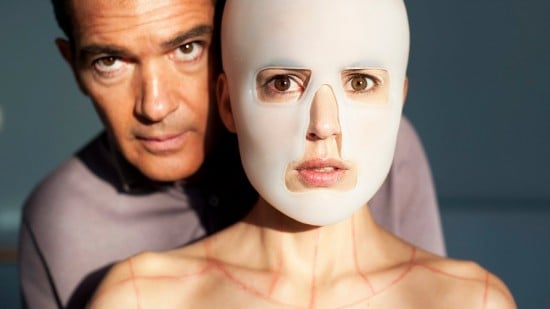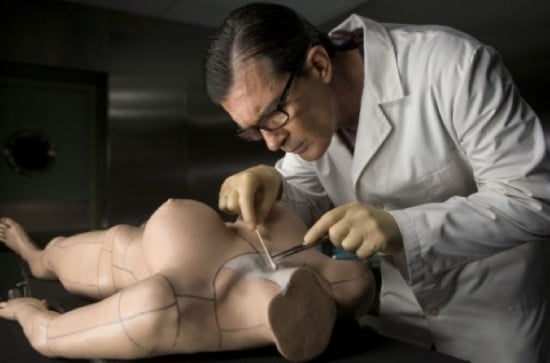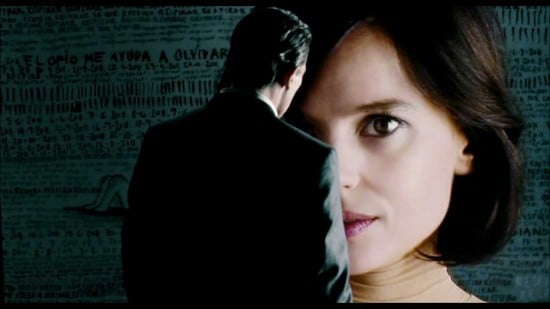Screen Time (4)
By:
November 15, 2015

One in a series of 10 posts reprinting Jacob Mikanowski’s film and television writing from Bright Lights Film Journal and elsewhere.
The Skin I Live In, dir. Pedro Almodóvar (2011). This essay originally appeared in The Rumpus.
Here’s a game: try to imagine what great directors would do if they had been forbidden by some cosmic entity from making films. Usually it’s easy – they would have kept doing what they did before. Jean Renoir would have stayed in theater. Sam Fuller would have stuck with the scandal sheets. Terence Malick would still be teaching Wittgenstein. Sometimes it takes more of a leap. Alfred Hitchcock might have become a hypnotherapist. Howard Hawks, president of a racetrack. John Huston, wildcat driller. Jim Jarmusch and Aki Kaurismaki would be in bands — one on bass, the other on drums. Jean-Luc Goddard, professor of semiology. Truffaut, literature. Robert Altman, general manager of the Bakersfield Blaze. And Pedro Almodóvar? He’d work in fashion, obviously. Or would he be a surgeon?
One of those two for sure, in any case. After all, surgery and tailoring aren’t all that different, and they have a lot to do with making films: all of them involve cutting and sewing, stitching and splicing and selecting the right material and form for the job. The two professions also correspond with the different periods of Almodóvar’s career — the hysterical melodrama of the early pictures and the consummate craftsmanship of the late ones. Part of the brilliance of The Skin I Live In, Almodóvar’s ingenious new thriller, is that it gives him a chance to pit these two artistic alter-egos against each other and have it out in a fight to the death.

The surgeon in the picture is Dr. Robert Ledgard. Played by Antonio Banderas, he’s a mix of icy suavity and confused tenderness, part grieving husband and part disciplined monster. A brilliant plastic surgeon, he runs a private clinic in his home, a mansion outside Toledo named El Cigarral, surrounded by olive groves and tall, tall fences. Besides cosmetic work, he has some ethically dubious sidelines in black market surgery and cutting-edge genetic research. On his off days, Ledgard has been working on making an indestructible super-skin, impervious to cuts or burns, by hybridizing human cells with pig genes. Almodóvar has great fun showing him tooling around his pristine basement lab in flamenco boots, putting the final touches on his Franken-skin before breakfast. When he presents the idea at a conference, the crowd is horrified, but he reassures them that, of course, it’s all just theoretical.
The tailor in the picture is a mysterious young woman named Vera (Elena Anaya). When we first meet her, she is doing yoga moves on a gym ball and wearing flesh-colored bodysuit which covers every inch of her skin besides her face. The skin we see is extraordinary, and uncanny — flawless and impermeable, it seems to be made out of some glowing mineral substance, like opal. Her beautifully furnished room is filled with art supplies, books on the artist Louise Bourgeois and little figures she has made out of sown-together rags. When Vera undresses, it becomes clear that she is just like her sculptures. Her body is covered in a network of surgical scars, dividing up every part of her body like a pattern drawn on a tailor’s dummy or one of those diagrams that shows you which cut of beef is which.

We soon realize that Vera is a captive. She can’t leave her chamber. Her breakfast arrives from downstairs via dumbwaiter, along with a volume of Alice Munro stories. She has to order it from the housekeeper, an intimidating woman (Marisa Paredes, who played Huma the actress in All About My Mother) who was once Ledgard’s nanny and still treats him like a son.
Vera’s room is also under surveillance. Ledgard watches her on an immense screen in his room, zooming in on her face until it fills up the whole wall. He’s obsessed. She’s his love object and his science project. She’s also his creation — and a recreation. Ledgard has replaced Vera’s original skin with his transgenic replacement, and altered her appearance to make her look like just like his deceased wife, who died after being burnt in a fiery car wreck. (This being an Almodóvar film, this wasn’t enough to kill her: Ledgard’s surgical skill saves her life, setting up an even more operatic death involving a balcony, a mirror and a nostalgic melody).
By reconstructing Vera in his wife’s image and giving her damage proof-skin, Ledgard takes on the two classic mad scientist tasks: cheating death, like in Frankenstein, and resurrecting beauty, like in George Franju’s Eyes Without A Face, the closest filmic precedent for The Skin I Live In in subject and tone. But Vera isn’t a corpse, or Ledgard’s disfigured daughter. She’s an enigma. This becomes the central mystery of the film: who is Vera, where did she come from, and why has Ledgard chosen her for all this?
The answer comes in a series of increasingly baroque and brilliantly layered flashbacks. It involves Almodóvar’s usual bonkers stew of kidnappings, vanished relatives, betrayals, murders and conflagrations, this time fitted out with an added layer of relatively discrete torture and all-too-graphic rape. The result is often lurid and occasionally horrific. At times — as when a psychopath appears on the scene in a tiger costume, complete with bobbing, phallic tail — it’s also darkly comic. It’s never campy though. Almodóvar shoots everything with too much elegance and restraint for that, never letting the demented action upset the perfect composition of his shots. This creates an odd dissonance. The Skin I Live In feels like a naughty picture dashed off by an Old Master painter, which might be why Dr. Ledgard keeps a huge copy of Titian’s Venus of Urbino above his staircase.
All of the baroque machinery in The Skin I Live In conceals a rigorous structure and a tender heart. This is an exceptionally well-designed film, in which everything — every person, every event, and every gesture — has a double. Some of these doubles seem trivial — the way Antonio Banderas licks a honey dipper, a vintage dress that vanishes, only to reappear. Others, like crimes which rebound across generations, and Vera’s multiple skins (as well as many things too sensitive to the plot to mention), are more obviously integral. Together, the presence of all these duplications and repetitions gives The Skin I Live In some of the feeling of Hitchcock’s Vertigo, at once bizarrely excessive and clock-work precise. It’s like a Gothic Faberge egg, or one of those mansions in a story by Borges, “abounding in useless symmetries and maniacal repetitions.”
But at the same time, The Skin I Live In is less of a departure for Almodóvar than it seems at first. He never loses sight of the main plot: the battle between appearance and identity. Skin is where we meet the world. With surprising subtlety, The Skin I Live In asks whether that’s all it is: are we wedded to our bodies, or does identity live somewhere else, where only yogis fear to tread? And beneath that, easy to miss, is the question that recurs in all of Almodóvar’s movies: if everything about us changes, will the people who love us still know who we are?
CURATED SERIES at HILOBROW: UNBORED CANON by Josh Glenn | CARPE PHALLUM by Patrick Cates | MS. K by Heather Kasunick | HERE BE MONSTERS by Mister Reusch | DOWNTOWNE by Bradley Peterson | #FX by Michael Lewy | PINNED PANELS by Zack Smith | TANK UP by Tony Leone | OUTBOUND TO MONTEVIDEO by Mimi Lipson | TAKING LIBERTIES by Douglas Wolk | STERANKOISMS by Douglas Wolk | MARVEL vs. MUSEUM by Douglas Wolk | NEVER BEGIN TO SING by Damon Krukowski | WTC WTF by Douglas Wolk | COOLING OFF THE COMMOTION by Chenjerai Kumanyika | THAT’S GREAT MARVEL by Douglas Wolk | LAWS OF THE UNIVERSE by Chris Spurgeon | IMAGINARY FRIENDS by Alexandra Molotkow | UNFLOWN by Jacob Covey | ADEQUATED by Franklin Bruno | QUALITY JOE by Joe Alterio | CHICKEN LIT by Lisa Jane Persky | PINAKOTHEK by Luc Sante | ALL MY STARS by Joanne McNeil | BIGFOOT ISLAND by Michael Lewy | NOT OF THIS EARTH by Michael Lewy | ANIMAL MAGNETISM by Colin Dickey | KEEPERS by Steph Burt | AMERICA OBSCURA by Andrew Hultkrans | HEATHCLIFF, FOR WHY? by Brandi Brown | DAILY DRUMPF by Rick Pinchera | BEDROOM AIRPORT by “Parson Edwards” | INTO THE VOID by Charlie Jane Anders | WE REABSORB & ENLIVEN by Matthew Battles | BRAINIAC by Joshua Glenn | COMICALLY VINTAGE by Comically Vintage | BLDGBLOG by Geoff Manaugh | WINDS OF MAGIC by James Parker | MUSEUM OF FEMORIBILIA by Lynn Peril | ROBOTS + MONSTERS by Joe Alterio | MONSTOBER by Rick Pinchera | POP WITH A SHOTGUN by Devin McKinney | FEEDBACK by Joshua Glenn | 4CP FTW by John Hilgart | ANNOTATED GIF by Kerry Callen | FANCHILD by Adam McGovern | BOOKFUTURISM by James Bridle | NOMADBROW by Erik Davis | SCREEN TIME by Jacob Mikanowski | FALSE MACHINE by Patrick Stuart | 12 DAYS OF SIGNIFICANCE | 12 MORE DAYS OF SIGNIFICANCE | 12 DAYS OF SIGNIFICANCE (AGAIN) | ANOTHER 12 DAYS OF SIGNIFICANCE | UNBORED MANIFESTO by Joshua Glenn and Elizabeth Foy Larsen | H IS FOR HOBO by Joshua Glenn | 4CP FRIDAY by guest curators
